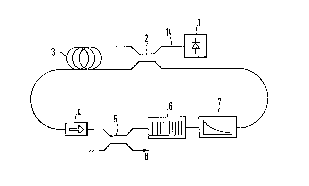Une partie des informations de ce site Web a été fournie par des sources externes. Le gouvernement du Canada n'assume aucune responsabilité concernant la précision, l'actualité ou la fiabilité des informations fournies par les sources externes. Les utilisateurs qui désirent employer cette information devraient consulter directement la source des informations. Le contenu fourni par les sources externes n'est pas assujetti aux exigences sur les langues officielles, la protection des renseignements personnels et l'accessibilité.
L'apparition de différences dans le texte et l'image des Revendications et de l'Abrégé dépend du moment auquel le document est publié. Les textes des Revendications et de l'Abrégé sont affichés :
| (12) Demande de brevet: | (11) CA 2240855 |
|---|---|
| (54) Titre français: | LASER A PEIGNE OPTIQUE |
| (54) Titre anglais: | LASER FOR GENERATING AN OPTICAL COMB |
| Statut: | Réputée abandonnée et au-delà du délai pour le rétablissement - en attente de la réponse à l’avis de communication rejetée |
| (51) Classification internationale des brevets (CIB): |
|
|---|---|
| (72) Inventeurs : |
|
| (73) Titulaires : |
|
| (71) Demandeurs : |
|
| (74) Agent: | ROBIC AGENCE PI S.E.C./ROBIC IP AGENCY LP |
| (74) Co-agent: | |
| (45) Délivré: | |
| (22) Date de dépôt: | 1998-07-17 |
| (41) Mise à la disponibilité du public: | 1999-01-18 |
| Licence disponible: | S.O. |
| Cédé au domaine public: | S.O. |
| (25) Langue des documents déposés: | Anglais |
| Traité de coopération en matière de brevets (PCT): | Non |
|---|
| (30) Données de priorité de la demande: | ||||||
|---|---|---|---|---|---|---|
|
Laser conçu pour produire un peigne optique. Ce laser comporte les éléments suivants : un milieu actif contenu dans un résonateur; un dispositif conçu pour transmettre au milieu actif la lumière de pompage d'une source de pompage; un dispositif permettant de faire sortir le peigne laser produit; et au moins un filtre optique, placé dans le résonateur et servant à produire le peigne. En insérant un filtre, on obtient un affaiblissement des caractéristiques de gain du milieu actif variant avec la longueur d'onde. Le gain annulaire prend ainsi une valeur unitaire sur une grande plage de valeurs, et plusieurs modes du peigne se mettent alors à osciller dans le résonateur.
A laser for generating an optical comb is disclosed
comprising an active laser medium enclosed in a
resonator, means for coupling pump light from a pump
source into the active medium, means for coupling out
the generated laser comb, and at least one optical
filter within the resonator for generating the comb. A
filter for introducing a wavelength-dependent loss
within the gain profile of the active medium is
inserted in the resonator. As a result, the ring gain
becomes unity over a wide range, and many modes of the
comb start oscillating in the resonator.
Note : Les revendications sont présentées dans la langue officielle dans laquelle elles ont été soumises.
Note : Les descriptions sont présentées dans la langue officielle dans laquelle elles ont été soumises.

2024-08-01 : Dans le cadre de la transition vers les Brevets de nouvelle génération (BNG), la base de données sur les brevets canadiens (BDBC) contient désormais un Historique d'événement plus détaillé, qui reproduit le Journal des événements de notre nouvelle solution interne.
Veuillez noter que les événements débutant par « Inactive : » se réfèrent à des événements qui ne sont plus utilisés dans notre nouvelle solution interne.
Pour une meilleure compréhension de l'état de la demande ou brevet qui figure sur cette page, la rubrique Mise en garde , et les descriptions de Brevet , Historique d'événement , Taxes périodiques et Historique des paiements devraient être consultées.
| Description | Date |
|---|---|
| Demande visant la révocation de la nomination d'un agent | 2016-06-10 |
| Demande visant la nomination d'un agent | 2016-06-10 |
| Inactive : CIB de MCD | 2006-03-12 |
| Demande non rétablie avant l'échéance | 2003-07-17 |
| Le délai pour l'annulation est expiré | 2003-07-17 |
| Réputée abandonnée - omission de répondre à un avis sur les taxes pour le maintien en état | 2002-07-17 |
| Lettre envoyée | 1999-07-26 |
| Demande publiée (accessible au public) | 1999-01-18 |
| Symbole de classement modifié | 1998-09-25 |
| Inactive : CIB en 1re position | 1998-09-25 |
| Inactive : CIB attribuée | 1998-09-25 |
| Inactive : Certificat de dépôt - Sans RE (Anglais) | 1998-08-28 |
| Demande reçue - nationale ordinaire | 1998-08-26 |
| Date d'abandonnement | Raison | Date de rétablissement |
|---|---|---|
| 2002-07-17 |
Le dernier paiement a été reçu le 2001-06-21
Avis : Si le paiement en totalité n'a pas été reçu au plus tard à la date indiquée, une taxe supplémentaire peut être imposée, soit une des taxes suivantes :
Les taxes sur les brevets sont ajustées au 1er janvier de chaque année. Les montants ci-dessus sont les montants actuels s'ils sont reçus au plus tard le 31 décembre de l'année en cours.
Veuillez vous référer à la page web des
taxes sur les brevets
de l'OPIC pour voir tous les montants actuels des taxes.
| Type de taxes | Anniversaire | Échéance | Date payée |
|---|---|---|---|
| Enregistrement d'un document | 1998-07-17 | ||
| Taxe pour le dépôt - générale | 1998-07-17 | ||
| Enregistrement d'un document | 1999-03-03 | ||
| TM (demande, 2e anniv.) - générale | 02 | 2000-07-17 | 2000-06-20 |
| TM (demande, 3e anniv.) - générale | 03 | 2001-07-17 | 2001-06-21 |
Les titulaires actuels et antérieures au dossier sont affichés en ordre alphabétique.
| Titulaires actuels au dossier |
|---|
| ALCATEL |
| Titulaires antérieures au dossier |
|---|
| THOMAS PFEIFFER |